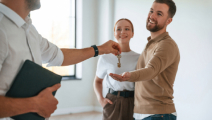Exterior cladding options: pros and cons
Redoing exterior cladding involves more than just aesthetics, especially if your existing cladding is cracked or damaged. Your home’s exterior protects it from structural damage and water leakage and helps keep it insulated. Which is the best material for your home? What sort of upkeep do different types of cladding require? Read on to find out how to choose the best exterior cladding for your property, and the pros and cons of various materials.
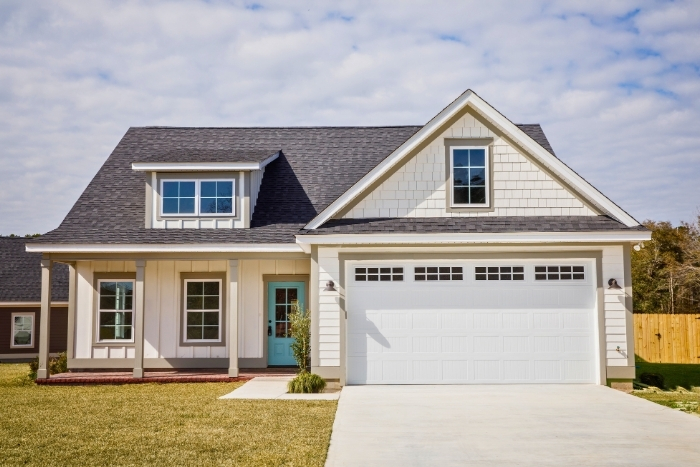
Signs that it’s time to redo your exterior cladding
Take a moment to look at the exterior of your property. What do you see? How would you describe the exterior cladding? Is it a bit worn or faded, or is there visible damage?
Either way, be sure to check the condition of your exterior cladding on a regular basis so you can intervene fast in case of damage. In addition to adding visual appeal, cladding is essential for protecting the structure and improving overall energy efficiency. It creates a barrier against water infiltration, temperature fluctuations, and even certain kinds of pests.
Signs that it’s time to redo your cladding include:
- Paint flaking off or fading
- Misshapen or buckled areas
- Visible cracks or holes
- Signs of moisture, mold, or dampness, inside or outside
- Brick or stonework: frost boil, cracks
- End of the cladding’s useful life
- Water infiltration, musty odor
- Presence of vermin in the structure
- Rising electricity bills
- Aesthetic reasons
- Etc.
It’s important to inspect both your home’s exterior and interior. Any sign of water leakage, moisture or mould could indicate a crack in the exterior cladding. Be on the lookout!
Vinyl
Vinyl, also called PVC, is one of the most common types of exterior cladding used in Quebec homes.
Pros of vinyl exterior cladding
- Affordable: offers great value for your money.
- Low-maintenance: you’ll never have to paint or stain it. However, regular washing will keep it looking good as time passes.
- Durable and resistant to Quebec weather: vinyl doesn’t rot or rust.
- Quick and easy installation: the cost of labour is low.
- Option to add insulation: this improves energy efficiency.
- Plenty of aesthetic options: vinyl exterior cladding is available in many colours, textures and varieties, including faux stone.
Cons of vinyl cladding
- Sensitive to shock: if installed in cold weather, it may crack or break.
- Sensitive to heat: don’t place your barbecue too near.
- Expansion and contraction: there’s a high risk of warping if the vinyl is incorrectly installed.
- Less aesthetically pleasing: vinyl can lack character compared to natural materials. Some municipal by-laws regulate its installation.
- Environmental impact: vinyl is made of plastic. Although it can be recycled, in Quebec, it rarely is.
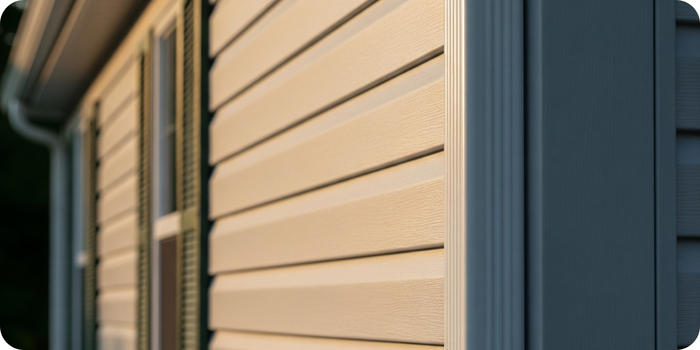
Aluminium
Aluminium was mainly used in the 1960s and 1970s. While its popularity for residential use subsequently declined, with only soffits, mouldings, and flashings made from aluminium, this material is now making a comeback.
Pros of aluminium exterior cladding
- Lightweight: it is easy to install.
- Corrosion-resistant: aluminium doesn’t rust.
- Non-combustible: aluminium is fire resistant.
- Low maintenance: it doesn’t rot or crack, and requires little cleaning.
- Durable: it is resistant to temperature variations.
- Recyclable: a major pro.
Cons of aluminium cladding
- Sensitivity to dents and shock: it can be damaged more easily than other materials.
- Noise: as aluminum expands and contracts, you’ll hear cracking noises, and the sound of rain when it hits the metal.
- Discoloration: depending on the quality of the cladding, it can tarnish over time, requiring a fresh coat of paint.
- Cost: it is generally more expensive than vinyl, which explains its decline in popularity.
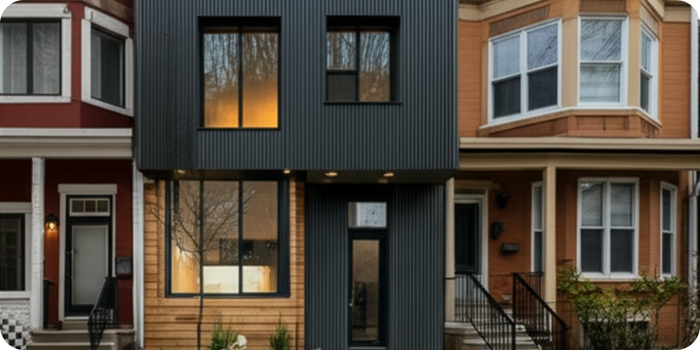
Engineered wood or CanExel
CanExel is a type of engineered wood made of high-density fibre (HDF). The product consists of 95% wood fibre, with resin and wax added, and is hot pressed for durability. Paint is then applied and baked on.
Pros of CanExel or engineered wood exterior cladding
- Warm aesthetic: this material has the elegance of wood, with many different tones and styles available. Vertical CanExel exterior cladding is also very trendy.
- Very durable: it is manufactured for resistance to extreme weather (freezing/thawing, humidity).
- Low maintenance: it doesn’t require regular painting or staining.
- Good dimensional stability: it doesn’t warp like solid wood does.
- Resistant to insects and rotting.
Cons of CanExel
- Sensitivity to major shock: it may split or get damaged.
- Cost: it is generally more expensive than vinyl or aluminium.
- CanExel must be carefully installed to ensure performance and waterproofing.
- Repairs: they can be complicated and sometimes visible.
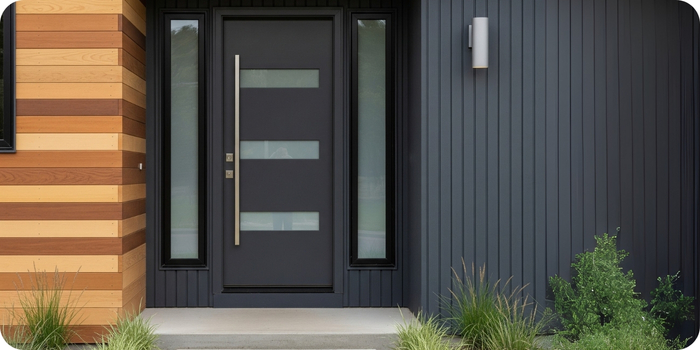
Steel
Steel exterior cladding has many advantages and a modern, architectural look. The company MAC Métal Architectural offers this material as a high-end product, designed and manufactured in Quebec.
Pros of steel exterior cladding
- Exceptional durability: it is highly resistant to shock, bad weather (hail, wind, heavy snow), deformation and temperature fluctuations.
- Low maintenance: steel doesn’t rot, rust (if properly treated), crack, or need regular repainting.
- Fire resistance: steel is non-combustible, which is a major safety advantage.
- Modern and versatile aesthetic: this material is available in various colours, textures and styles (e.g., clapboard, corrugated metal, wood finish), making it adaptable to various looks.
- Eco-friendliness: steel is a highly recyclable material.
Cons of steel cladding
- High upfront cost: steel is generally more expensive than vinyl or aluminium.
- Specialized installation: specific expertise is required for proper installation and to ensure waterproofing.
- Sensitivity to corrosion (when the cladding is damaged): if the protective finish is pierced, the steel may rust.
- Noise: you may hear noise as it expands and contracts, and the sound of rain (although less than with aluminum).
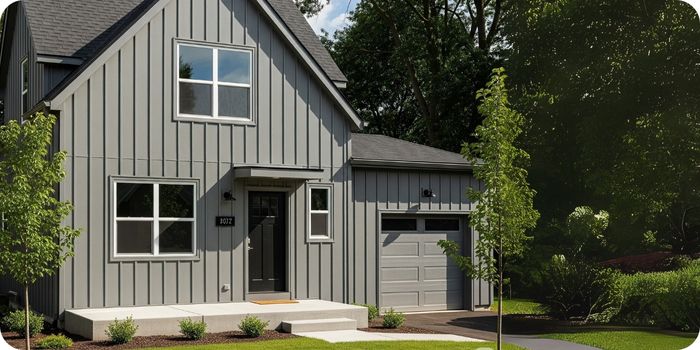
Brick
Brick is a timeless choice and very durable. There are different types of brick to choose from: reconstituted, fired clay, and concrete.
Pros of brick exterior cladding
- Exceptional durability: brick can last over 100 years.
- Very low maintenance: it doesn’t require painting, just minimal cleaning.
- Excellent fire resistance.
- Very good thermal insulation and soundproofing.
- Superior weather resistance, including typical Quebec cycles of freezing and thawing.
- Adds value to the property: a major advantage when you sell.
- Classic and timeless aesthetic: brick has maintained its prestige.
Cons of brick exterior cladding
- Very high initial cost: materials and installation are expensive.
- Long, complicated installation process: it takes qualified masons.
- May need mortar repointing over the years to maintain effectiveness.
- Moisture buildup can occur without proper ventilation behind the bricks.
- More limited selection of colours and textures compared to other types of cladding.
- It may be difficult to hide repairs when brick is damaged.
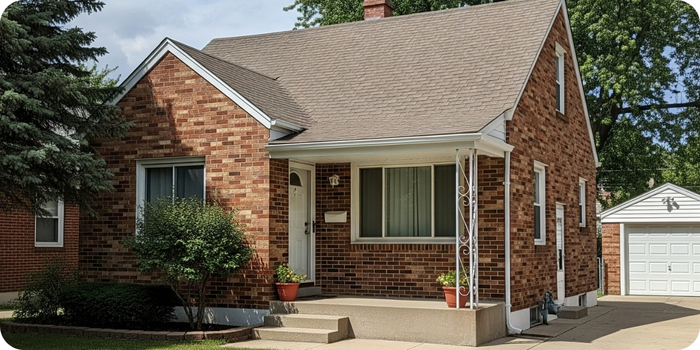
Natural stone
Natural stone is another timeless, high-quality material for exterior cladding. Available in a range of textures, colours and styles, natural stone will bring out the best in your property.
Pros of natural stone exterior cladding
- High-end aesthetic: natural stone adds a touch of prestige.
- Exceptional durability: natural stone lasts for generations.
- Very low maintenance: this material requires little upkeep.
- Highly resistant to fire and inclement weather.
- Outstanding thermal insulation and soundproofing properties.
- Considerable added value to the property: a major advantage when you sell.
- Synthetic stone, or faux stone exterior cladding, is lighter and cheaper than natural stone.
Cons of natural stone exterior cladding
- High initial investment: natural stone is expensive to buy and install.
- Complicated installation process: requires specific expertise.
- Weight: the support structure must be sturdy to withstand natural stone.
- Less design flexibility once installed.
- Synthetic stone, although durable, is slightly less shock-resistant than natural stone.
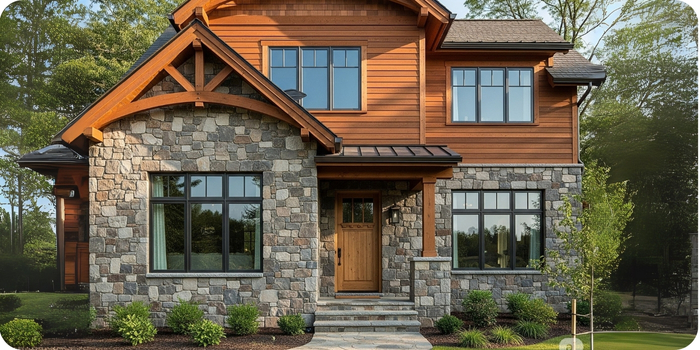
Acrylic
Acrylic is similar to the stucco popularized in 1970s basement ceilings, but in a version adapted for exterior cladding. This material, made of cement, fiberglass and polystyrene, was popular in the 1990s.
Pros of acrylic exterior cladding
- With its seamless, modern aesthetic, acrylic cladding is very flexible in terms of design, available in smooth or contemporary finishes with multiple textures.
- Wide variety of colours.
- Lightweight: acrylic adds less weight to the structure than other materials.
Cons of acrylic exterior cladding
- Less durable: acrylic is easily marked, and may be punctured or cracked upon major impact, exposing its inner layer.
- High initial cost: it is more expensive than vinyl or aluminium, comparable in price to fibre cement.
- Specific installation requirements: to guarantee waterproofing and durability, it must be carefully installed by certified professionals. This is particularly true in Quebec’s humid climate.
- Regular washing needs: the textured surface can retains dirt and dust.
- Complicated repairs: it is difficult to repair a section of this material without leaving visible marks.
- Low resistance to fire and inclement weather: acrylic can be fragile.
- It seals in water vapour from evaporating, preventing interior walls from drying out propery.
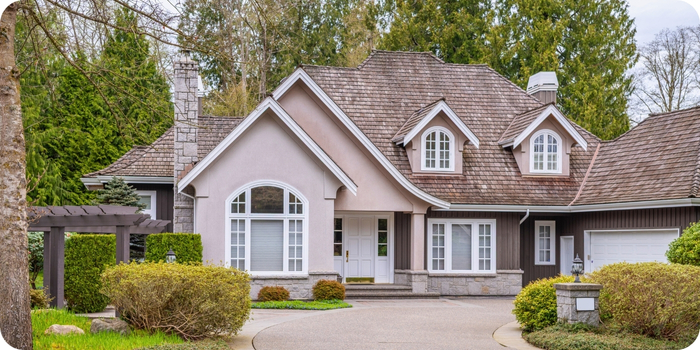
| Tips and tricks
Acrylic cladding has posed various problems in the past.If you decide on this material for your property’s exterior, ensure that the contractor includes a way to let interior walls dry out in case of water leakage or excess humidity. |
Natural wood
Natural wood is a classic choice for Quebec homes. There are a wealth of choices, including spruce, white pine, white cedar, larch, or torrefied wood, each with its own benefits.
Pros of natural wood exterior cladding
- Unparalleled warmth and naturalness.
- Great stylistic versatility: adaptable to a modern, rustic or country look. Wooden exterior cladding can also be installed vertically.
- Excellent natural thermal insulation: it outperforms most other types of cladding (15 times better than concrete and 6 times better than brick).
- Durable: with proper maintenance, some types of wood can last for decades.
- Renewable and eco-friendly material if harvested from sustainably managed forests.
- Easily repaired: replacing individual planks is simple.
Cons of wooden exterior cladding
- High-maintenance: paint, stain, or sealant must be re-applied regularly to protect against moisture, UV rays, and insects.
- Untreated natural wood is vulnerable to moisture, rotting, and insects.
- Flammable: it should come as no surprise that wood is highly combustible.
- Higher initial investment, in general: this is especially true of higher-quality varieties, pre-treated, and pre-stained wood.
- Unprotected wood can also expand, contract, deform, or crack due to climatic variation.
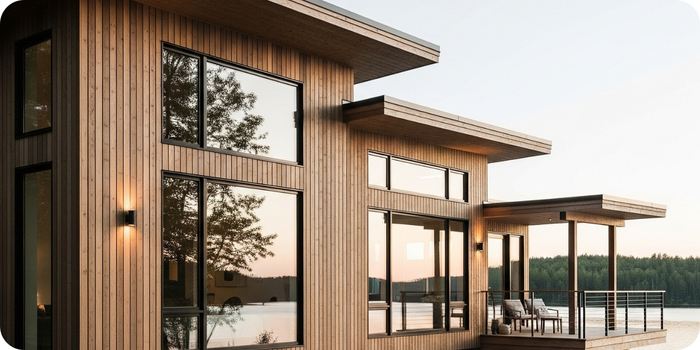
Fibre cement
Fibre cement combines several materials: cement, water, cellulose fibres, textile fibres, and additives. Like CanExel, it is formed into solid but lightweight boards. Paint is then applied and baked on for improved durability.
Pros of fibre cement external cladding
- Extremely durable: fibre cement cladding is resistant to inclement weather, insects, rodents, and mould.
- Non-combustible: fibre cement is flameproof.
- Low maintenance: it doesn’t need frequent repainting and is highly resistant to discoloration.
- Good stability: planks don’t expand or contract as much as vinyl and wood do.
- Looks expensive: fibre cement can mimic wood grain and other textures.
- Good shock resistance.
Cons of fibre cement cladding
- Higher upfront cost than vinyl or aluminium.
- Heavy and brittle: installation requires professionals with specialized equipment.
- May absorb moisture if improperly sealed.
- Risk of mould on the surface if poorly maintained.
- Repairs can be difficult and costly.
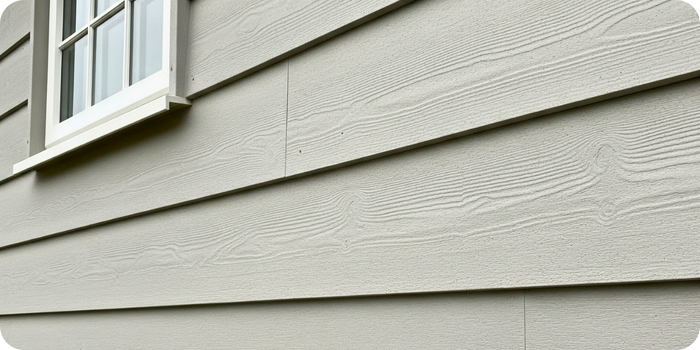
Cost, useful life, and environmental impact of exterior cladding
Consult our comparative chart of materials to help you evaluate exterior cladding options based on cost, useful life, and environmental impact.
|
|
|||
|
Type of cladding |
Cost per ft2 (including installation) |
Average useful life |
Environmental index |
|
Vinyl |
$2 to $7 |
40+ years |
🌿 🌿 |
|
Aluminium |
$4.50 to $12 |
40+ years |
🌿 |
|
Engineered wood or composite lumber |
$3.50 to $11.50 |
25+ years |
🌿🌿🌿 |
|
Steel |
$4 to $10 |
40+ years |
🌿 |
|
Brick and natural stone |
$10.50 to $43 |
75+ years |
🌿 |
|
Acrylic |
$8 to $10 |
25+ years |
🌿 |
|
Natural wood |
$5 to $14 |
25–55 years |
🌿🌿🌿 |
|
Fibre cement |
$3.50 to $8.50 |
40+ years, although certain durability issues have emerged |
🌿 |
*Note that the information is approximate and for informational purposes only.
As you can see, exterior cladding comes in a range of prices, from vinyl cladding, which is the least expensive, to brick or natural stone cladding, which are the most expensive.
Buying a house is a major milestone, and planning is key to make sure it goes smoothly. Before and during the purchase process as well as after buying a home, here are 13 expenses to remember for your budget.
How to maintain your exterior cladding
When selecting exterior cladding, consider the maintenance it will need over time. Some materials require little to no maintenance. Others require consistent upkeep to protect your house’s outermost layer from deterioration.
Recommended maintenance for each type of cladding:
- Vinyl: regular washing; some colours may require UV protection to prevent fading
- Aluminium: low maintenance, but can be repainted if it fades
- CanExel: regular washing
- Steel: low maintenance, but must be repaired if damaged to prevent rust
- Brick and natural stone: need minimal washing, but may need mortar repointing
- Acrylic: needs regular washing; hard to repair
- Natural wood: high-maintenance (needs paint, stain, and/or sealant every 3 to 5 years), but easy to repair
- Fibre cement: low-maintenance
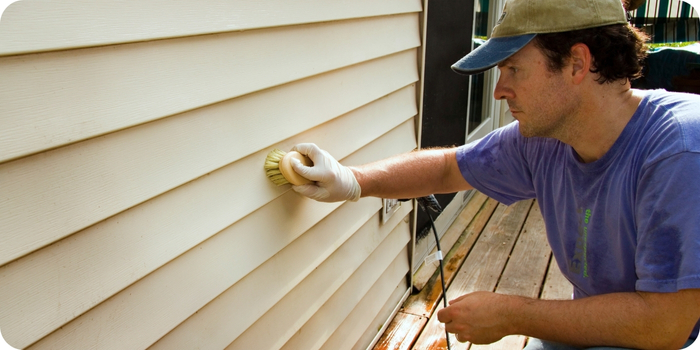
| Tips and tricks
Visually inspect cladding at least twice a year for signs of deterioration such as cracked joints/seams, loose attachments, or signs of infiltration. |
Extend exterior cladding’s useful life by avoiding these mistakes
Certain habits can damage your exterior cladding or make it less durable. Here are some things to avoid to help your cladding last:
- Using a pressure washer or abrasive cleaners: hand wash your cladding with mild soap and water. Rinsing it off with a garden hose is also recommended.
- Placing a barbecue too close to the wall: materials such as vinyl and acrylic can melt or deform near intense heat. Smoke can also stain your cladding over time.
- Planting shrubs or climbing plants too close to the walls: humidity builds up, increasing the risk of mould, rot, and water infiltration.
- Blocking soffits or vents: this prevents proper air circulation, which compromises the overall structure.
- Leaning or stacking wood, furniture or other objects against the walls: prevents walls from breathing, creates an environment conducive to humidity and insects.
- Piercing the cladding without taking precautions: every hole or attachment must be properly sealed to prevent water infiltration.
- Improper installation: while installing cladding may seem simple, it must be done by a professional. Renovation without expert advice poses a risk of water infiltration or blocked ventilation, and may void the manufacturer's warranty.
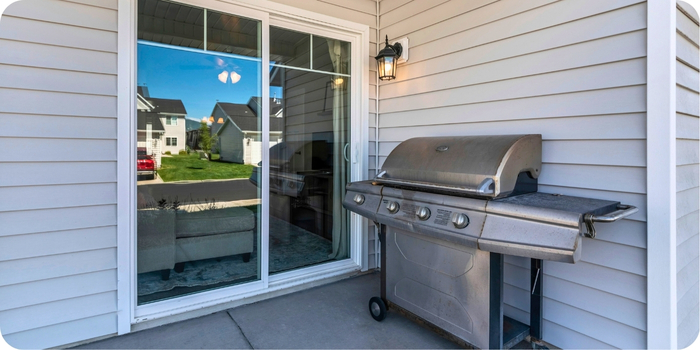
| Tips and tricks
Do you own a plex? Know your legal obligations. According to the Building Chapter of the Safety Code, it is mandatory to inspect and maintain the facades of buildings with 5 or more above-ground storeys , and the owner’s legal responsibility. Regardless of whether you reside in the building, you are responsible for making sure the external maintenance of the home (or plex) gets done. |
In sum: exterior cladding is essential for your home’s protection
Many materials are available for your property’s exterior cladding, but they vary in terms of weather resistance, durability, the environmental impact of their production, and the cost of buying and installing them.
Be sure to do your own research, reach out to salespeople, and seek out answers to questions that arise. Walk around your neighborhood and look at your neighbours’ houses. Which materials did they use? What style do you like? You could knock on a few doors to chat and ask for references.
One thing is certain: exterior cladding helps protect your home and your investment. Thinking it through may be worth your while.
Frequently asked questions (FAQ)
1. What are the latest trends in exterior cladding?
For the past few years, neutral and earth tones in different materials and textures have been trending consistently, along with pale wood. The overall impression is a timeless, natural look with a touch of environmental consciousness.
2. What type of exterior cladding is least expensive?
Vinyl is the least expensive. Not only does it cost less than other types of cladding, it’s also cheaper to have installed. With a bit of elbow grease and some help, many are even capable of installing it themselves.
3. When is the best time to change your exterior cladding?
Late winter to late spring (late April to June) and early autumn (September and October) are good times to do work on your home’s facade or exterior. While it can be harder to find a contractor during the high season, summer is also a good time for different types of work.

See also:
How to install, maintain and close an above-ground pool
7 outdoor trends for your dream yard
The complete home renovation guide: tips, steps and budget
 The Largest Number of Homes for Sale
The Largest Number of Homes for Sale
